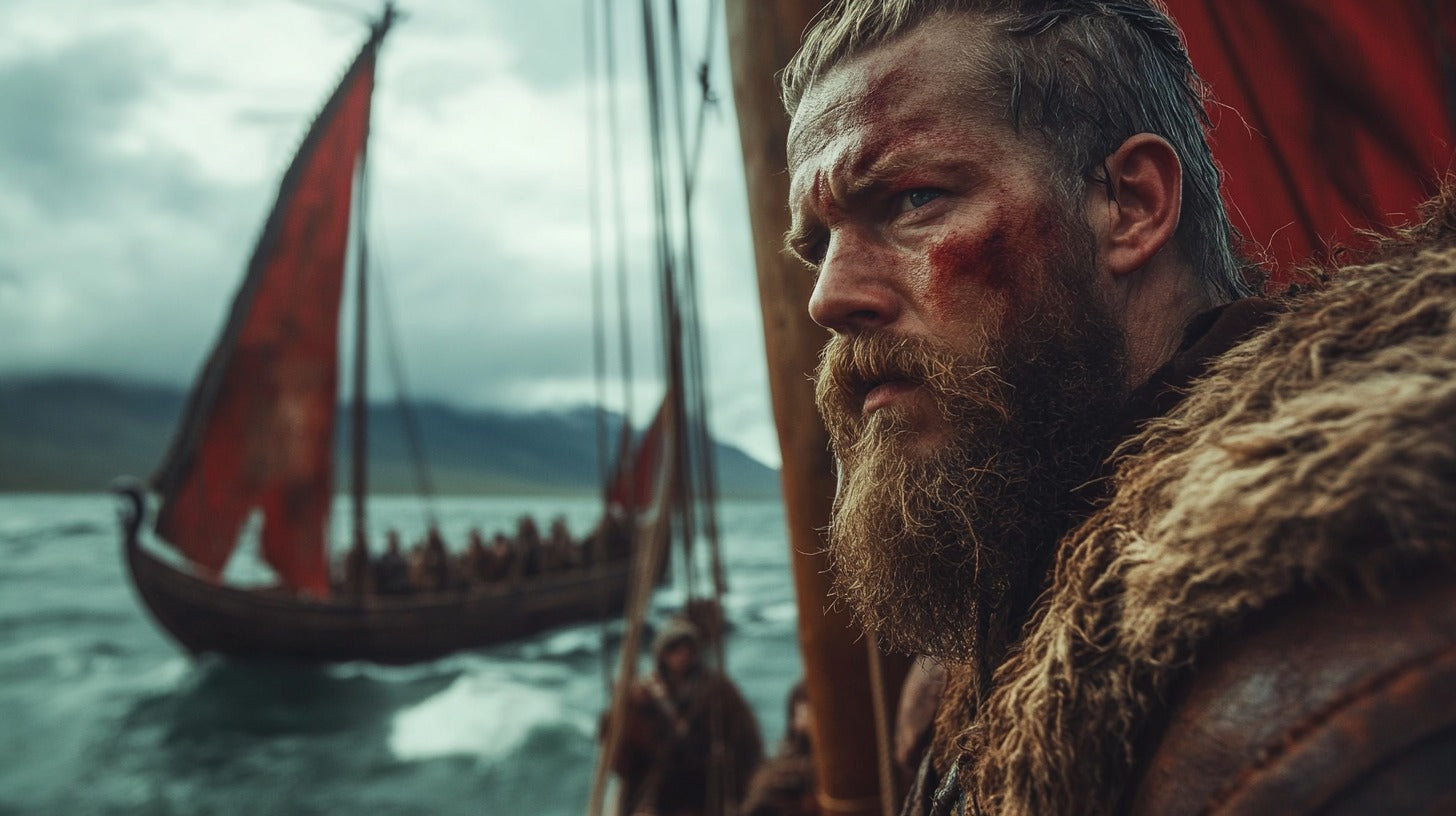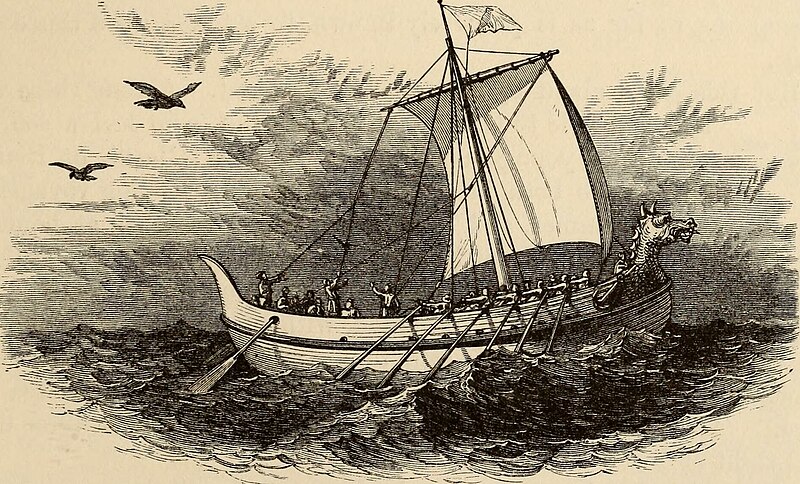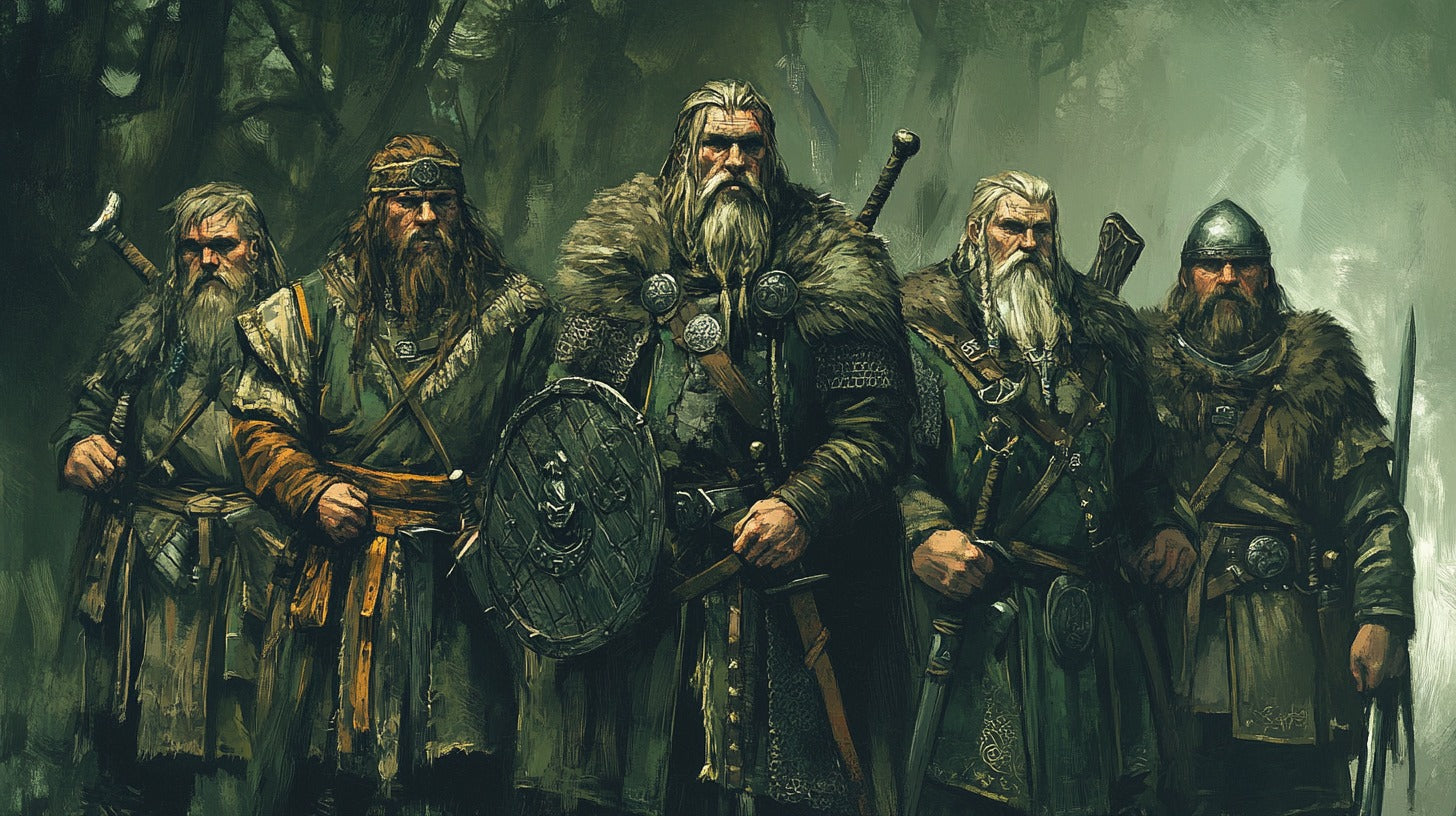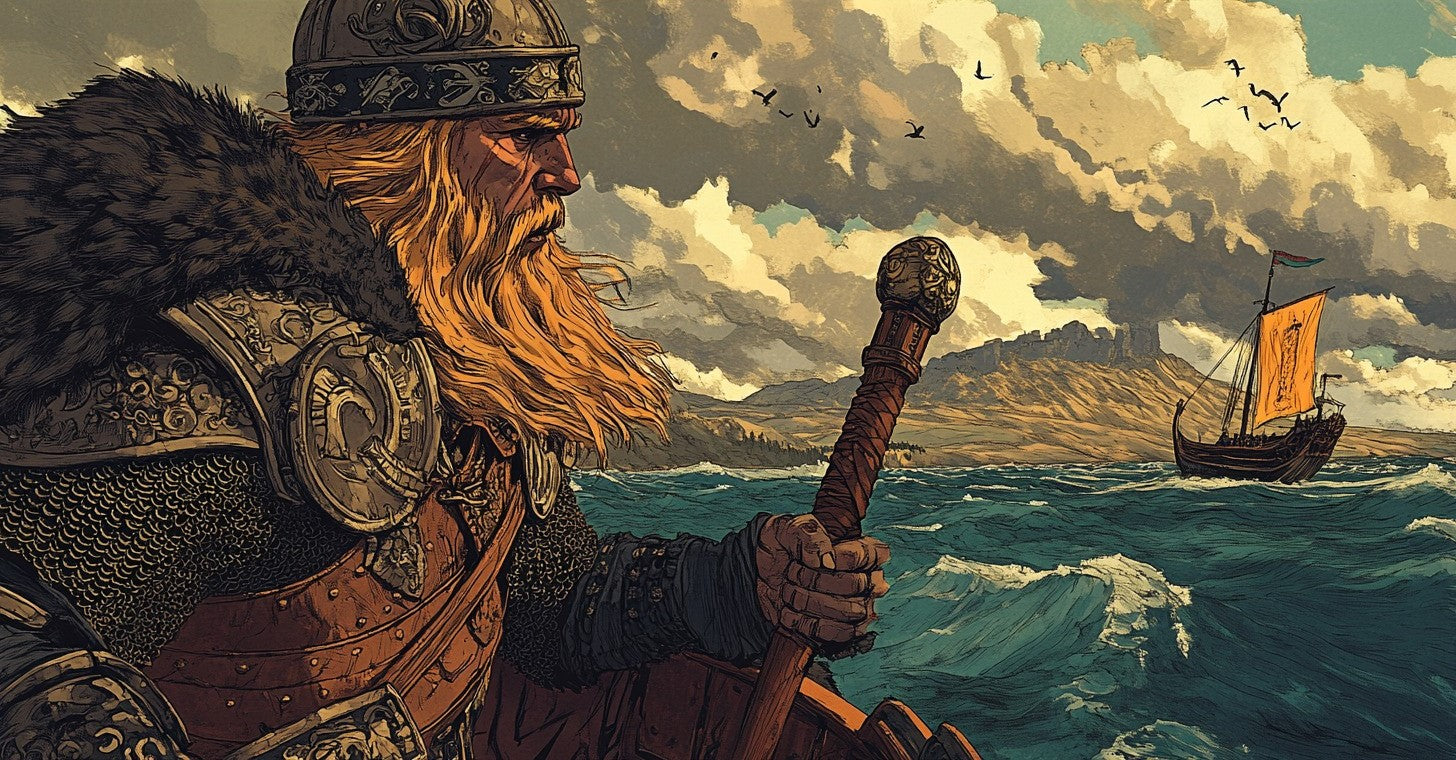
Hrafna-Flóki: The Raven-Guided Viking Explorer
In the frigid waters of the North Atlantic, where icy winds howl like the wolves of Odin and waves crash against longships with the fury of Thor's hammer, a tale of adventure and discovery unfolds. This is the saga of Hrafna-Flóki, the Viking explorer whose name would be forever etched in the annals of history, carried on the wings of the very ravens that guided him to a land of fire and ice.
Early Life and Background
Viking Origins
The saga of Hrafna-Flóki begins in the rugged fjords of Norway, where the salt of the sea mingled with the blood of warriors. Born into a world of longships and legends, Flóki Vilgerðarson was destined for a life of adventure. The exact year of his birth remains shrouded in the mists of time, but we know he lived during the latter half of the 9th century, an era when Viking expansion was at its peak.
Family and Upbringing
Like a young sapling reaching for the sun, Flóki grew up under the shadow of great explorers and warriors. His father, Vilgerðr, was said to be a man of renown, though the details of his exploits have been lost to history. Young Flóki was raised on tales of distant lands and treacherous seas, his imagination set ablaze by the possibilities that lay beyond the horizon.
The Journey to Iceland

Floki sets his gaze upon the shores of Iceland / Illustration: Paganheim
Preparation and Motivation
What drives a man to sail into the unknown? For Flóki, it was a potent mixture of curiosity, ambition, and the restless Viking spirit. News of a large island to the northwest had reached Norwegian shores, whispered about in mead halls and around flickering hearths. Flóki, his heart pounding with the rhythm of crashing waves, decided to see this fabled land for himself.
Preparations for such a voyage were no small feat. Flóki gathered a crew of hardy men and women, each as eager as he to carve their names into the bedrock of history. They provisioned their ship with dried meat, fish, and enough ale to keep their spirits high during the long journey ahead.
The Raven Navigation Technique

Hrafna-Flóki sends out his ravens to find Iceland. 19th-century / Illustration: Wikimedia, Creative Commons.
Significance of Ravens in Norse Culture
It was during these preparations that Flóki earned the moniker that would follow him through the ages: Hrafna-Flóki, or Raven-Flóki. In Norse mythology, ravens held a place of great significance. Odin, the All-Father, was said to have two ravens, Huginn and Muninn, who flew across the world each day to bring him news.
Implementation of the Raven Strategy
Flóki, in a stroke of brilliance that would make him the talk of skalds for generations, decided to bring three ravens aboard his ship. These ebony-feathered navigators would become the key to his journey, a living compass guiding him through the vast emptiness of the North Atlantic.
As they sailed further from the familiar coastlines of Norway, Flóki released the first raven. It flew back towards land, indicating they had not yet traveled far enough. The second raven circled the ship before returning, suggesting they were truly in open waters. But it was the third raven that would change everything. Released into the salty air, it flew straight ahead, never to return. Flóki, his eyes gleaming with the reflected light of adventure, knew then that land lay ahead.
Arrival and Exploration of Iceland

Iceland / Photo: Kamil Porembiński
First Impressions
After weeks of battling tempestuous seas and biting winds, Flóki and his crew finally caught sight of their destination. The jagged coastline of Iceland rose from the waves like the spine of some great sea monster, its peaks shrouded in mist and mystery.
As they made landfall, the explorers were met with a landscape unlike anything they had ever seen. Vast fields of lava rock stretched as far as the eye could see, punctuated by steaming hot springs and thundering waterfalls. The air was crisp and clean, filled with the calls of unfamiliar birds and the distant rumble of glaciers.
Challenges Faced
But the land that had seemed so promising from afar soon revealed its harsh nature. The first winter was brutal, catching Flóki and his people unprepared. They had been so entranced by the beauty of their new home that they neglected to gather sufficient hay for their livestock. As the cold months dragged on, many of their animals perished, and the settlers found themselves facing the very real possibility of starvation.
The challenges they faced were not just physical but mental as well. The isolation of this new land, so far from everything familiar, weighed heavily on their spirits. Some of Flóki's crew began to whisper of abandoning the settlement, of returning to the green fields of Norway.
The Naming of Iceland

Despite its name, Iceland enjoys relatively mild temperatures compared to other places at similar latitudes, thanks to the warming effects of the Gulf Stream / Illustration: Paganheim
The Frost-Filled Fjords
It was during this difficult winter that Flóki, standing atop a high ridge and surveying the frost-covered landscape before him, made a decision that would echo through history. With a mixture of frustration and grudging admiration, he christened this challenging land "Iceland."
The name was born from the ice-choked fjords that had nearly trapped their ship, from the glaciers that loomed on the horizon, and from the biting cold that had tested their resolve. Yet even as he spoke the name aloud, there was a note of affection in Flóki's voice. This land, for all its harshness, had captured a piece of his heart.
Return to Norway
When spring finally arrived, bringing with it the promise of new beginnings, Flóki made the difficult decision to return to Norway. The journey back was one of mixed emotions. While part of him yearned for the comforts of home, another part couldn't shake the memory of Iceland's raw beauty and untamed spirit.
Legacy and Impact

Influence on Future Expeditions
Though Flóki's initial attempt at settlement had been unsuccessful, his journey laid the groundwork for future expeditions. The tales he brought back to Norway – of fertile fishing grounds, abundant timber, and a land ripe for the taking – sparked the imagination of other Vikings.
Ingólfr Arnarson, inspired by Flóki's accounts, would lead the first permanent Norse settlement of Iceland just a few years later. Without Flóki's pioneering spirit and his innovative use of raven navigation, the Norse colonization of Iceland might have taken a very different path.
Hrafna-Flóki in Norse Sagas
Flóki's adventure became the stuff of legend, recorded in the great Norse sagas. The Landnámabók, or Book of Settlements, speaks of his journey in detail, preserving his story for future generations. In these tales, Flóki is portrayed as a complex figure – part explorer, part innovator, and wholly human in his triumphs and failures.
Conclusion
The story of Hrafna-Flóki is more than just a historical account of Viking exploration. It's a testament to the human spirit of adventure, the drive to push beyond known boundaries and challenge the impossible. Flóki's journey reminds us that even in failure, we can leave an indelible mark on history.
As we look back on Flóki's life, we're reminded that true exploration isn't just about discovering new lands – it's about expanding the horizons of human knowledge and capability. In his innovative use of ravens for navigation, Flóki showed that sometimes the greatest discoveries come from looking at the world around us in new and unexpected ways.
Today, as we stand on the shoulders of giants like Hrafna-Flóki, we're called to embrace that same spirit of adventure and innovation. Whether we're exploring distant planets or the depths of our own potential, we carry with us the legacy of those brave souls who dared to sail into the unknown, guided by nothing more than curiosity and the flight of ravens.
FAQs
- Why was Flóki called "Hrafna-Flóki"?
Flóki earned the nickname "Hrafna-Flóki" (Raven-Flóki) because he used three ravens to help navigate his journey to Iceland.
- Did Hrafna-Flóki discover Iceland?
While Flóki wasn't the first to discover Iceland, he was one of the earliest Norse explorers to intentionally sail there and is credited with giving the island its name.
- How did the raven navigation technique work?
Flóki released three ravens at different points during his journey. The flight direction of the third raven, which didn't return to the ship, indicated the presence of land ahead.
- Why did Flóki name the land "Iceland"?
Flóki is said to have named the land Iceland after seeing a fjord full of drift ice during the harsh winter he spent there.
- What was the long-term impact of Flóki's expedition?
Although Flóki's settlement attempt was unsuccessful, his journey and the tales he brought back inspired future Norse expeditions, leading to the permanent settlement of Iceland. |
References
Byock, J. (2001). Viking Age Iceland. Penguin Books.
Karlsson, G. (2000). The History of Iceland. University of Minnesota Press.
Magnusson, M., & Palsson, H. (Trans.). (1965). The Vinland Sagas: The Norse Discovery of America. Penguin Classics.
Forte, A., Oram, R., & Pedersen, F. (2005). Viking Empires. Cambridge University Press.
Short, W. R. (2010). Icelanders in the Viking Age: The People of the Sagas. McFarland & Company.
"Iceland" by Kamil Porembiński is licensed under CC BY-SA 2.0.








